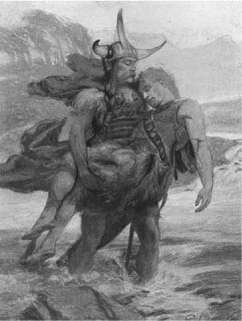Celtic MythologyCuchulainn and the Tain |
What is the rest of the story of Cuchulainn? |
Said to have lived in the first century B.C.E., Cuchulainn’s life is described in many versions beginning as early as the eighth century C.E. Cuchulainn is what Joseph Campbell called a monomythic hero. Like so many heroes, his life begins miraculously, his childhood reveals extraordinary powers, and his life is a quest marked by battles, monsters, femmes fatales, and a descent into the Underworld.
King Conchobar’s sister Dechtire is visited by the sun god Lugh in the form of a fly. Dechtire swallows the fly and the result is the birth of a boy whom Dechtire names Sentata. From the moment of his birth, Sentata is possessed of great power and talents. As a seven-year–old he fights off 150 attackers who hope to overpower the court of Conchobar. At the age of twelve he kills the great watchdog belonging to the smith, Culann, and as a punishment replaces the dog as the smith’s protector, changing his name to Cuchulainn (Culann’s Hound).
Cuchulainn falls in love with the beautiful Emer, and to win her hand agrees to undergo a series of trials that include confronting monsters and even, as did Odysseus and Aeneas, descending into the Underworld.
Cuchulainn’s most famous feat is victory in the war against Queen Medb, described in the Tain Bo Cuailnge, during which he acquires the enmity of the goddess Morrigan by rejecting her advances when she approaches him in her form as a beautiful femme fatale.
Cuchulainn’s life is not without tragedy. Aside from having to fight against his foster father and foster brother, he kills his son Conla as a result of mistaken identity, reminding us of Herakles’s killing of his wife, and finally he is not able to escape the vengeful power of Morrigan and her allies. With the approval of Morrigan, the young kings of Munster and Leinster, whose fathers Cuchulainn has killed in battle, trap him near the Pillar of Stone. Cuchulainn has arrived at the spot with his horse, Battle Gray, and his charioteer, Laeg. At the stone he is taunted by three bards, who threaten to defame him. He kills the bards, but the two young kings appear and kill Battle Gray and Leig and wound Cuchulainn. Cuchulainn ties himself to the Pillar of Stone so he can die standing. Morrigan, as a crow, perches defiantly on the hero’s shoulder, as Lughaid of Munster cuts off his head. Cuchulainn’s falling sword severs the offending arm of Lughaid.

The primary figure in the Ulster Cycle is Cuchulainn, depicted here in a 1905 illustration carrying Ferdiad, the foster brother he has mortally wounded.
